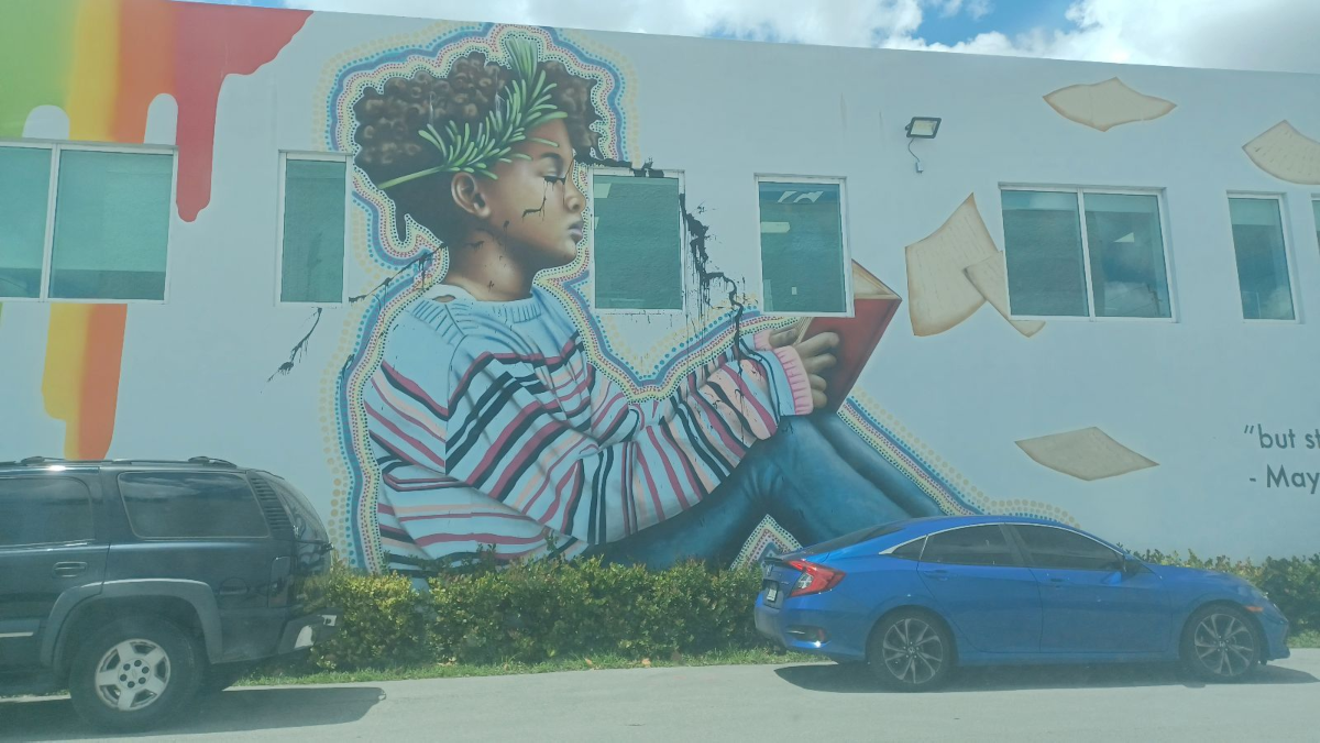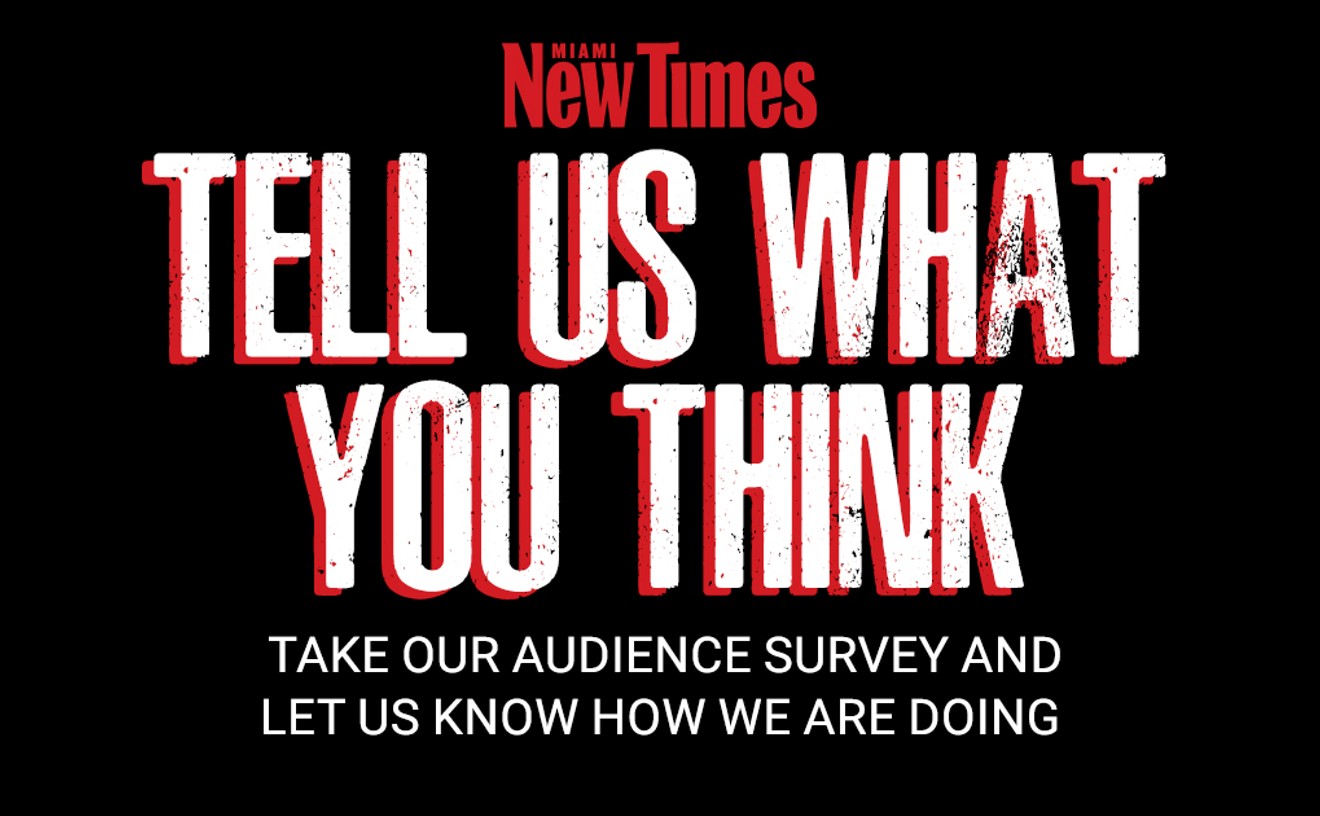A colorful piece of public art will be allowed to remain on the United Teachers of Dade (UTD) building in Miami Springs, over the objections of some city council members who fear the 3-2 vote at Wednesday night's special meeting puts the entire identity of their sleepy municipality at risk of becoming a rowdy destination art district.
"We don't want to be a wannabe Wynwood," Miami Springs Mayor Maria Puente Mitchell said from the dais. "Now every time something doesn't comply with code, every homeowner and business will ask for forgiveness instead of permission because that's the precedent we will set."
The meeting was called to resolve the teachers' union's appeal of a code violation issued last March for a mural that was painted on the side of its NW 36th Street headquarters more than a year ago. (The labor union, which boasts a membership of nearly 30,000 and is an affiliate of the American Federation of Teachers, is one of the largest teachers' unions in the nation.) The mural depicts a Black girl reading a book whose pages are fluttering away on a breeze, a hummingbird, and a famous quote from the poet Maya Angelou that reads, "but still, like the air, I'll rise!" The mural was vandalized this past September and still bears the scars, in the form of splashes of black and red paint. Though a security camera captured footage of the incident, Miami Springs police have been unable to identify the perpetrator.
According to the city's code compliance board, the mural violates a provision that "all commercial buildings within the applicable Business Districts of the City shall conform to the color palettes approved and authorized" by the city council. The city's Board of Adjustments recommended the council uphold that violation but also suggested that the city clarify the code.
That's because the Miami Springs code of ordinances does not specifically prohibit murals or public artwork in an area the city refers to as the "Northwest 36th Street District," where the UTD office building is located. The section of the code that regulates commercial signage specifically exempts murals in that area, and, as UTD attorney Javier Fernandez pointed out to the council on Wednesday night, murals aren't mentioned on the city's list of signage requiring a permit.
The city's attorney handling the matter, Alex Uribe, argued otherwise, stating that a lack of prohibition in the code does not constitute city approval.
"Just because you do not mention zoos in the code, does that mean someone can build a zoo on 36th Street, or a spaceport, if Elon Musk decides to come on down?" Uribe asked rhetorically.
Council member Walter Fajet, a principal at a local charter school, agreed that the teachers' union violated the code and should have asked the city's planning office for permission. Still, he said, he would side with the union to avoid the possibility of a costly lawsuit.
"I see that we're in a pickle here," Fajet said. "We all have the responsibility to not allow ourselves to get mired in litigation when there is no guarantee we're going to win. [UTD] is not going to let this go away, and our code is vague."
All four council members and the mayor agreed that the city's code is outdated and ambiguous on various matters, including public art. Miami Springs was incorporated in 1926, and council members noted that much of the code has not been updated in years.
Longtime council member Bob Best, who spoke in favor of the mural and was the first to vote to deny the city staff's recommendation, said the issue was one of the city's own making, and that it was unfair to penalize the union for following the letter of the law.
"The city's position was wrong. The ordinance as written was ambiguous in nature, so it was totally understandable that a new business on the block would be confused," Best told New Times after the meeting. "If we write the codes with ambiguity, shame on us."
Jacky Bravo, who has been outspoken in her opposition to the mural, proposed an ordinance earlier this month to prohibit Miami Springs homeowners from painting their houses in colors that are "too dark, deep, or bright."
In the end, Bravo and Mitchell voted to uphold the city's recommendation, while Best, Fajet, and council member Victor Vazquez voted against. The 3-2 vote removes the code violation and allows the mural to remain.
UTD president Karla Hernandez-Mats, a resident of Miami Springs, told New Times after the meeting that she's pleased with the outcome.
"We're happy we were able to come to an agreement," Hernandez-Mats said. "We feel bad we had to go through such a long process. We want to be good neighbors and want to make that area better and engage residents."
[
{
"name": "Air - MediumRectangle - Inline Content - Mobile Display Size",
"component": "19274298",
"insertPoint": "2",
"requiredCountToDisplay": "2"
},{
"name": "Editor Picks",
"component": "17482312",
"insertPoint": "4",
"requiredCountToDisplay": "1"
},{
"name": "Inline Links",
"component": "18711090",
"insertPoint": "8th",
"startingPoint": 8,
"requiredCountToDisplay": "7",
"maxInsertions": 25
},{
"name": "Air - MediumRectangle - Combo - Inline Content",
"component": "17482310",
"insertPoint": "8th",
"startingPoint": 8,
"requiredCountToDisplay": "7",
"maxInsertions": 25
},{
"name": "Inline Links",
"component": "18711090",
"insertPoint": "8th",
"startingPoint": 12,
"requiredCountToDisplay": "11",
"maxInsertions": 25
},{
"name": "Air - Leaderboard Tower - Combo - Inline Content",
"component": "17482313",
"insertPoint": "8th",
"startingPoint": 12,
"requiredCountToDisplay": "11",
"maxInsertions": 25
}
]












